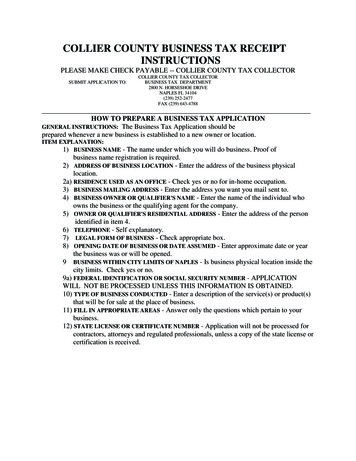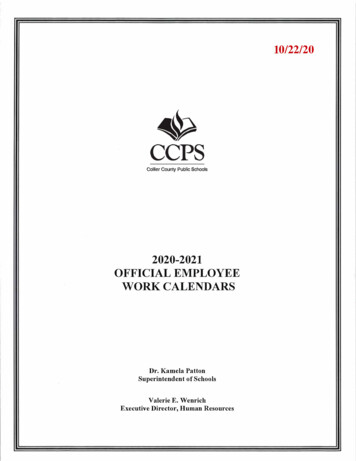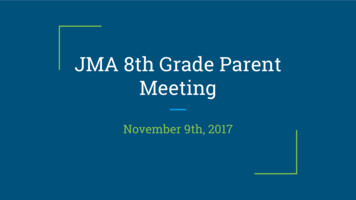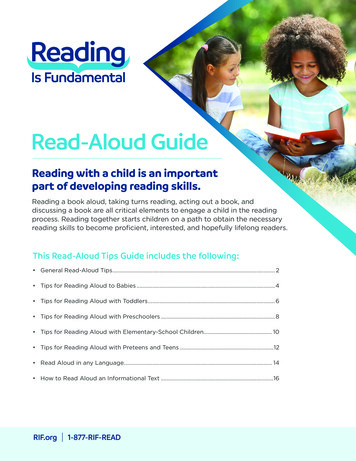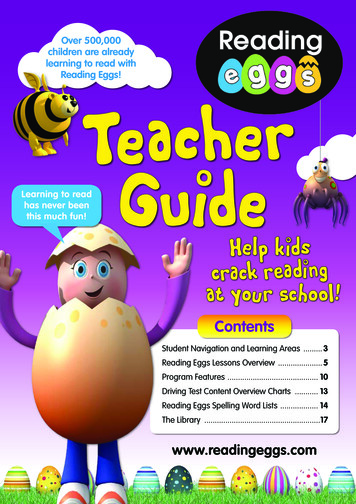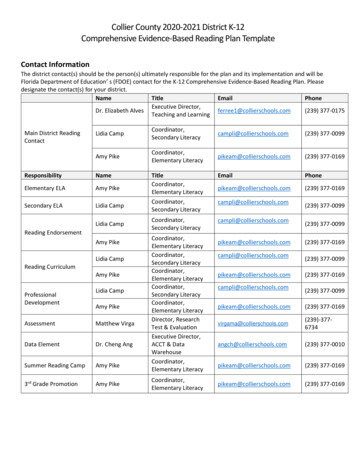
Transcription
Collier County 2020-2021 District K-12Comprehensive Evidence-Based Reading Plan TemplateContact InformationThe district contact(s) should be the person(s) ultimately responsible for the plan and its implementation and will beFlorida Department of Education’ s (FDOE) contact for the K-12 Comprehensive Evidence-Based Reading Plan. Pleasedesignate the contact(s) for your district.NameTitleEmailPhoneExecutive Director,Dr. Elizabeth Alvesferree1@collierschools.com(239) 377-0175Teaching and LearningMain District ReadingContactLidia CampCoordinator,Secondary Literacycampli@collierschools.com(239) 377-0099Amy PikeCoordinator,Elementary Literacypikeam@collierschools.com(239) 377-0169TitleCoordinator,Elementary LiteracyCoordinator,Secondary LiteracyEmailPhonepikeam@collierschools.com(239) 377-0169Coordinator,Secondary eElementary ELAAmy PikeSecondary ELALidia CampLidia CampReading EndorsementAmy PikeReading CurriculumProfessionalDevelopmentLidia CampAmy PikeLidia CampAmy PikeAssessmentMatthew VirgaData ElementDr. Cheng AngSummer Reading CampAmy Pike3rd Grade PromotionAmy PikeCoordinator,Elementary LiteracyCoordinator,Secondary LiteracyCoordinator,Elementary LiteracyCoordinator,Secondary LiteracyCoordinator,Elementary LiteracyDirector, ResearchTest & EvaluationExecutive Director,ACCT & DataWarehouseCoordinator,Elementary LiteracyCoordinator,Elementary ools.comcampli@collierschools.com(239) 377-0099(239) 377-0099(239) 377-0169(239) 377-0099(239) 377-0169(239) 377-0099pikeam@collierschools.com(239) ch@collierschools.com(239) 377-0010pikeam@collierschools.com(239) 377-0169pikeam@collierschools.com(239) 377-0169
Plan InformationHow is the district communicating the contents of its Comprehensive Evidence-Based Reading Plan to all stakeholders?The Comprehensive Evidence-based Reading Plan is shared with all school-based administrators at the opening ofschools meeting in July, with expectations for implementation and monitoring clearly communicated. Similarly, theplan will be communicated with all K-12 ELA/reading teachers during the preservice week at the start of school. CCPScurriculum maps and instructional expectations reflect strong alignment with the plan to ensure fidelity ofimplementation.Additionally, the Comprehensive Evidence-Based Reading Plan will be shared with parents and communitystakeholders at the Superintendent’s District Advisory Council meeting in September and posted on the Districtwebsite.
Monitoring of District K-12 Comprehensive Evidence-Based Reading Plan Implementation as required by 6A-6.053(1)(a) F.A.C.District-Level Leadership 6A-6.053(7) F.A.C.K-5Component ofReadingOral languagePhonologicalawarenessPhonicsFluencyWhat data is being collected?Assessment type(e.g., screener, diagnostic, progressmonitoring/formative, summative)How is the data beingcollected?Progress monitoring assessment types and data collection procedures will be in accordance with guidanceProfessional Learning on October 28, 2020.Assessment ToolsProgress monitoring/summativeRenaissance platform-Star Assessment –Renaissance (K)Progress monitoring/formativeTeacher assesses eachDiagnostic and progress monitoringchild individually-iReady (K-5)iReady platform-Letter/Sound Identification (based onAn Observation Survey of EarlyLiteracy Achievement by Marie M.Clay) (K only)-Phonological Awareness Inventory(K)Data CollectedRhyming, alliteration, sentencesegmenting, syllable blending, andsegmentingAssessment ToolsProgress monitoring/summativeRenaissance platform-Star Assessment –Renaissance(K)Progress monitoring/formativeiReady platform-iReady (K-5)Diagnostic and progress monitoringTeacher assesses each-Formal Fountas and Pinnel Runningchild individuallyRecordData CollectedLetters, letter sounds,and phonic patternsAssessment ToolsProgress monitoring/summativeiReady platform-Star Assessment –RenaissanceProgress monitoring/formativeTeacher assesses each-iReady (K-5)Diagnostic and progress monitoringchild individually-Dolch High Frequency WordTeacher assesses eachAssessment (K,1,2)child individually-Formal Fountas and Pinnel RunningRecord-District created Fluency Rubric (K-5)Data CollectedSpeed, accuracy, and prosodyHow often is the databeing collected?from JRF following theRenaissance -Onetime a year -Augustfirst 30 days of schoolThree times a year:August, January, &MayOne time a year August- first 30 daysof schoolThree times a year:August, January, &MayThree times a year:August, January, &May
VocabularyComprehensionAssessment Tools-Star Assessment –Renaissance (K)-iReady (K-5)-Formal Fountas and Pinnel RunningRecordData CollectedKnowledge and usage of ongrade level vocabularyAssessment Tools-Star Assessment –Renaissance (K)-iReady Students (K-5)-District created ComprehensionRubric (K-5)-Formal Fountas and Pinnel RunningRecordData Collectedunderstanding of the text6-12Progress Monitoring ToolWhat data is being collected?Progress monitoring/summativeProgress monitoring/formativeDiagnostic and progress monitoringiReady platformTeacher assesses eachchild individuallyThree times a year:August, January, &MayProgress monitoring/summativeProgress monitoring/formativeDiagnostic and progress monitoringiReady platformTeacher assesses eachchild individuallyThree times a year:August, January, &MayAssessment type(e.g., screener, diagnostic, progressmonitoring/formative, summative)Scholastic ReadingInventoryStudent reading level in the form Diagnostic and progress monitoringof a Lexile levelScholastic PhonicsInventoryInformation regarding fluency ofphonological decoding and sightword recognitionStudent performance andprogress regarding LAFSDistrict QuarterlyBenchmark AssessmentDiagnostic and progress monitoringProgress monitoring formativeassessmentHow is the data beingcollected?Information is availablethrough the ScholasticManagement SystemInformation is availablethrough the ScholasticManagement SystemStudents participate in aquarterly assessmentsimilar to the FSAHow often is the databeing collected?Three times a year:September,December, MayThree times a year:September,December, MayThree times a year:October, December,April
K-12 Data Analysis and Decision-making as required by 6A-6.053(1)(b) F.A.C.How often is thedata beingreviewed and bywhom?What problem-solvingsteps are in place formaking decisionsbased on the data?QuarterlyBenchmarkAssessments andprogram specificdata is collectedthree times peryear.Data is reviewed byschool (classroomteachers, readingcoaches andadministrators) anddistrict levelstakeholdersData from iReady andother diagnosticassessments isregularly reviewed byteachers, coaches andprincipals. Overallclass progress, as wellas individual studentgrowth, is monitoredfor instructionaladjustments.Data Analysis and Decision-makingWhat steps is the districtHow are concerns communicated if it istaking to see building anddetermined that the K-12 Reading Plan isclassroom level data and tonot being implemented in an explicitshare findings withmanner, based on data to meet the needsindividual schools?of students?Quarterly benchmarkSchool principals have the responsibilityassessment data andto ensure that all students receive highprogram data is sharedquality grade level instruction withdistrictwide during Dataappropriate support and interventionsDialogues which occurwhen applicable. When data indicateimmediately following each that students are not making progress,assessment window.district staff (principal supervisor,Schools are required tocurriculum coordinator and others asindividually report progressappropriate) may visit classrooms to(or lack thereof) to theidentify instructional concerns andSuperintendent’s Cabinetdevelop a plan of support. Persistentalong with plannedissues are addressed by Cabinetinstructional modifications.leadership during Data Dialogues.Cabinet members askprobing questions andprovide feedback duringthese discussions. All schoolprincipals attend DataDialogue to learn from oneanother.Who at the district level isresponsible for providing planimplementation oversight,support and follow-up?Executive Director, Teaching andLearningExecutive Directors, SchoolLeadershipDistrict ELA CoordinatorsSchool Level Leadership 6A-6.053(8) F.A.C.PracticeWeekly readingwalkthroughs byadministratorsData chatsWho ensures that thepractice is informedby a specific purpose?AssociateSuperintendent forTeaching and LearningHow is thepurposecommunicated?Principal andreading coachmeetingsHow often is the data beingcollected?How is the data being sharedand by whom?WeeklyPrincipals will share dataduring school leadershipteam meetingsHow often is the databeing reviewed and bywhom?Principal Supervisors willreview data during theirmonthly school visitsAssociateSuperintendent forTeaching and LearningPrincipal andreading coachmeetingsMonthlyPrincipals will share dataduring school leadershipteam meetingsPrincipal Supervisors willreview data during theirmonthly school visits
ReadingLeadershipTeam per 6A6.053(3) F.A.C.Monitoring ofplanimplementationAssociateSuperintendent forTeaching and LearningPrincipal andreading coachmeetingsMonthlyPrincipals will share dataduring regular faculty andPLC meetingsPrincipal Supervisors willreview data during theirmonthly school visitsAssociateSuperintendent forTeaching and LearningPrincipal andreading coachmeetingsMonthlyPrincipals will share dataduring school leadershipteam meetingsPrincipal Supervisors willreview data during theirmonthly school visitsWhat problem-solving steps are in placefor making decisions based on data?Data from iReady and other diagnosticassessments is regularly reviewed byteachers, coaches and principals. Overallclass progress, as well as individualstudent growth, is monitored forinstructional adjustments.Implementation and Progress-monitoringHow are concerns communicated if it isHow will district leadership provide plan implementationdetermined that the plan is not beingoversight, support and follow-up?implemented in a systematic and explicit manner,based on data to meet the needs of students?School principals have the responsibility toReading plan implementation will be a standing agendaensure that all students receive high qualityitem on monthly principal and reading coach meetings withgrade level instruction with appropriate supportan emphasis on data driven instructional decision making.and interventions when applicable. When dataDistrict staff, including principal supervisors and ELAindicate that students are not making progress,content specialists, will visit school at minimum on adistrict staff (principal supervisor, curriculummonthly basis for the purpose of observing literacycoordinator and others as appropriate) may visitinstruction, attending grade level PLC meetings, and schoolclassrooms to identify instructional concerns and leadership team meetings. District support will be provideddevelop a plan of support. Persistent issues areas needed to support school implementation.addressed by Cabinet leadership during DataDialogues.
Professional Development per 6A-6.053(4) F.A.C.RequirementHow is itcommunicatedto principals?How is itmonitored byprincipals?Training in multisensoryreading interventionBeginning ofyear principalmeetingDifferentiated professionaldevelopment with intensityincreased for those teacherswhose progress monitoringdata is not showingadequate growthIdentification of mentorteachersBeginning ofyear principalmeetingClassroomobservations,meetings withreading coach, PLCdiscussions andplanningClassroomobservations,meetings withreading coachEstablishing of modelclassrooms within the schoolProviding teachers with timeweekly to meet together forprofessional developmentincluding lesson study andPLCsBeginning ofyear principalmeetingBeginning ofyear principalmeetingBeginning ofyear principalmeetingMonthly mentorteacher ounds scheduleAdministratorattendance,meeting minutesHow often is itreported to thedistrict and in whatformat?QuarterlyTo whom is it reportedat the district?Principal SupervisorsWho at the district level isresponsible for following up ifthe professional developmentrequirement isn’t happening?Principal SupervisorsQuarterlyPrincipal SupervisorsPrincipal SupervisorsMonthlyProfessional LearningDepartmentPrincipal SupervisorsQuarterlyPrincipal SupervisorsPrincipal SupervisorsQuarterlyPrincipal SupervisorsPrincipal Supervisors
InstructionK-5 Uninterrupted 90 minute Daily Reading Block per 6A-6.053(9)(a) F.A.C.RequirementWhole group instruction utilizingan evidence-based sequence ofreading instructionSmall group differentiatedinstruction in order to meetindividual student needsHow is itcommunicated toprincipals?CCPS CurriculumGuides provideexplicitexpectations forliteracy instruction.This information isreviewed withprincipals on amonthly basis atprincipal meetings.CCPS CurriculumGuides provideexplicitexpectations forliteracy instruction.This information isreviewed withprincipals on amonthly basis atprincipal meetings.How is it monitoredby principals?How is it reported to thedistrict?Weekly literacywalkthroughobservations; formalteacher observations;reading coachobservationsData DialoguesWeekly literacywalkthroughobservations; formalteacher observations;R2eading coachobservationsData DialoguesTo whom is itreported at thedistrict?PrincipalSupervisors andCabinetHow often is it reportedto the district?PrincipalSupervisors andCabinetQuarterlyQuarterly
Budget per 6A-6.053(2) F.A.C.How is the district prioritizing K-3 students with substantial reading deficiencies in the use of its ResearchBased Reading Instruction Allocation funds?CCPS recognizes the priority of ensuring that students in grades K-2 receive high quality instruction andare reading on grade level by third grade. This priority is reflected in the use of the state readingallocation funds. Additionally, the district allocates significant local resources to support K-12 readinginstruction, including strategic intervention programming for students who are not yet meeting theexpectations of grade level standards.Reading Allocation Budget ItemEstimated proportional share distributed to district charterDistrict expenditures on reading coaches assigned to elementary schoolsDistrict expenditures on reading coaches assigned to secondary schoolsDistrict expenditures on intervention teachers assigned to elementary schoolsDistrict expenditures on intervention teachers assigned to secondary schoolsDistrict expenditures on supplemental materials or interventions for elementary schoolsDistrict expenditures on supplemental materials or interventions for secondary schoolsDistrict expenditures on reading coaches assigned to elementary schoolsDistrict expenditures on reading coaches assigned to secondary schoolsDistrict expenditures on professional developmentDistrict expenditures on helping teachers earn the reading endorsementDistrict expenditures on summer reading campsDistrict expenditures on additional hour for school on the list of 300 lowest performingelementary schoolsFlexible Categorical SpendingSum of ExpendituresAmount of District Research-Based Reading Instruction 062,262,3822,262,382Summer Reading CampAll Summer Reading Camp teachers are required to be highly effective and reading endorsed/certified.An addendum will be sent out the last week of August 2020 requesting specific information.What evidence-based instructional materials are being used for Summer Reading Camp?iReady, Reading Horizons, Scholastic Lit CampWill students in grades other than 3 be served also? Yes No If yes, which grade levels? Rising 3rd and 5th grade studentsReading Allocation Literacy CoachesMinimum Qualifications per 6A-6.053(6)(d) F.A.C.:Coaches must meet the following criteria: reading endorsement or reading certification experience as successful classroom teachers knowledge of evidence-based reading research special expertise in quality reading instruction and infusing reading strategies into instruction data management skills
strong knowledge base in working with adult learnersexcellent communication skillsoutstanding presentation, interpersonal, and time-management skillsAn addendum will be sent out the last week of August 2020 requesting specific information.What problem-solving method was used to determine which schools have the greatest need based onstudent performance data in reading per 6A-6.053 F.A.C.? (Please attach any rubrics or related artifacts)The District utilizes a number of data indicators to tier schools for District Support. These indicatorsinclude: student performance data in ELA and math, subgroup performance in ELA and math, schoolreport card data, student demographics (race/ethnicity, ELL, ESE, FRL), teacher assignment, andschool leadership. All schools receive Tier I supports that include monthly visits by district staff,intervention materials, teacher training and ongoing professional learning, and coaching support.Tier II and III school support includes increased frequency and intensity of District support andoversight.How have you communicated to principals, coaches, teachers, and district staff that coaches are not askedto perform administrative functions that will confuse their role for teachers; and that they are to spendlimited time administering or coordinating assessments?During Opening of Schools Principal Meetings, the roles and responsibilities of reading coaches isreviewed, including specific guidance on weekly allocation of time and tasks. This information is alsoshared during Opening of Schools Reading Coach meetings and reinforced during monthly meetings.Principal supervisors and District literacy staff monitor reading coach activities to ensure activitiesare strategically aligned with school and district priorities.Who is monitoring whether that is adhered to? Whom do coaches go to with concerns if theserequirements are not followed?Principal supervisors and District literacy staff monitor reading coach activities to ensure activitiesare strategically aligned with school and district priorities. District literacy staff oversee and supporta cadre of schools and are the direct point of contact for coaching concerns.Coaching Model per 6A-6.053(6)(b) F.A.C.Is your district using the Just Read, Florida! coaching model? Yes No If you checked no, please complete and submit the Alternative Coaching Model document.If you checked yes, please fill out the following chart:Requirements of the Just Read, Florida! Coaching Model per 6A-6.053(6)(c) F.A.C.
Provide professional development on the following:o the major reading components, as needed, based on an analysis of student performance datao administration and analysis of instructional assessmentso providing differentiated instruction and intensive intervention Model effective instructional strategies for teachers Facilitate study groups Train teachers in data analysis and using data to differentiate instruction Coach and mentor colleagues Provide daily support to classroom teachers Work with teachers to ensure that evidence-based reading programs are implemented with fidelity Help to increase instructional density to meet the needs of all students Help lead and support reading leadership teams at their school(s) Continue to increase their knowledge base in best practices in reading instruction, intervention, andinstructional reading strategies Work frequently with students in whole and small group instruction to model and coach in otherteachers’ classroomsHow are theserequirements beingcommunicated toprincipals?Beginning of YearPrincipal meetingContinual discussionat monthly principalmeetingsHow are coachesrecording theirtime and tasks?Who at thedistrict level ismonitoring this?Coaches plan fortheir work withschooladministration inalignment withthe schoolimprovementplan.Time and tasksare recorded inan Outlookcalendar.Elementary andSecondary ELACoordinatorsand Districtliteracy staffHow often isthe data beingreviewed?What problem-solvingsteps are in place formaking decisions basedon the data?Weekly withSchool-based LiteracyReading Coach Team meets regularlyand school(weekly or bi-weekly) toadministration; review data from iReadymonthly byand other diagnosticELAassessments and dataCoordinatorsfrom classroomobservations. Overallclass progress, as well asindividual studentgrowth, is monitored forinstructionaladjustments.District literacy staffsupport school levelReading Coaches.Other ConsiderationsReading Intervention Data Element per 6A-6.053(7)(e)Reporting of data elements is required by the K-12 Comprehensive Evidence-Based Reading Planwithin the Automated Student and Staff Data Base System. These data elements include: Student Enrollment in Reading Intervention; Reading Endorsement competency status for teachers; Reading Certification progress status for teachers.Charter schools per 6A-6.053(5)Charter schools must utilize their proportionate share of the research-based reading allocation inaccordance with Sections 1002.33(7)(a)2.a., and 1008.25(3)(a), F.S. All intensive reading interventions
specified by the charter must be delivered by a teacher who is certified or endorsed in reading.Instructional Continuity PlanGiven that it is important to plan ahead for any contingency, please attach your Instructional ContinuityPlan for 2020-2021 if you wish to have it reviewed by Just Read, Florida! We will offer feedback andsuggest resources.Curriculum/Instruction/Assessment Decision Trees per 6A-6.053(9)(c)Use the following decision tree template to address ALL district students. What follows is one tree thatcan be copied as needed. The template can be used for grade bands or for individual grades.The Decision Trees must contain the following information: The grade level(s) of students the decision tree is addressing Name and performance benchmark on screening, diagnostic, progress monitoring, localassessment, statewide assessment or teacher observations used to identify students withsubstantial deficiencies in reading and subsequent interventions provided A description of the intensive, explicit, systematic and multisensory reading interventions whichwill be provided to students in grades K-3 Information on how the Florida Kindergarten Readiness Screener will be used to identifystudents for intervention Core curriculum and K-12 intervention materials that address the six (6) components of reading:oral language, phonological awareness, phonics, fluency, vocabulary, and comprehension The methods for providing reading instruction and intervention to students who may continueto receive instruction through distance or blended learning
Curriculum, Instruction, and Assessment Decision TreeGrade Level(s): K-12IF:Student meets the following criteria at beginning of school year:Grades K-2 iReady scores above 15 percentile.Grades 3 – 10 Student scores at or above proficiency level on the state accountabilityassessment and iReady score above 15 percentile, 70% scale score the SY20 District QuarterTwo benchmark assessment, course grades for SY20.THEN:TIER 1 OnlyInitial instruction: is standards-aligned builds background and content knowledge, motivation provides print rich, systematic, scaffolded, and differentiated instruction incorporates writing in response to reading includes accommodations (IEP, ESOL or 504) incorporates the principles of Universal Design for Learning includes specially designed instruction for students with disabilitiesCore CurriculumTIER 1Please indicate your core curriculum and how its use by the students served is supported by strong evidence,moderate evidence, or promising evidence.Elementary: CCPS curriculum is based on the LAFS benchmarks and is supported by state provided resourcesthrough CPALMS and Just Read Florida! Savvas Reading Street and Ready LAFS are used as the Core Tier 1 resource.Progress monitoring through Quarterly Benchmark assessments and iReady Diagnostic assessments (three times ayear) provides promising evidence to support a correlation between instructional practices, including the use ofresources, and student performance.Secondary: CCPS curriculum is based on the LAFS benchmarks and is supported by state provided resources throughCPALMS and Just Read Florida! HMH Florida Collections is used as the Core Tier 1 resource. Progress monitoringthrough Quarterly Benchmark assessments provides promising evidence to support a correlation betweeninstructional practices, including the use of resources, and student performance.Progress MonitoringAssessment & FrequencyPerformance Criteria thatindicates Tier 1 is sufficientPerformance Criteria to thatwould prompt addition of Tier 2interventionsAll students: CCPS Quarterly Benchmarkassessments conducted in October,December and AprilAll Elementary: iReady assessmentconducted in August, January, & MayCCPS Quarterly BenchmarkProficient score (70% scalescore) and/or improved scoreat each assessment periodiReady score of above 15percentile.How is the effectiveness of Tier 1instruction being monitored?What procedures are in place to identify and solve problems toimprove effectiveness of Tier 1 instruction?Grade level Data Chats are held regularly to monitor studentprogress and make instructional adjustments. Additional supportDecline to a below proficientscore from one assessmentperiod to the next. Lack ofprogress as indicated byassessment score
Teacher observation, classroomformative assessments, analysis ofstudent work, data chatsfrom reading coaches and/or other staff is provided whereneeded.How is the effectiveness of Tier 1curriculum being monitored?Quarterly Benchmark AssessmentsClassroom observationsWhat procedures are in place to identify and solve problems toimprove effectiveness of Tier 1 curriculum?School leadership team meetings focus on regular review of dataand observation trends. Additionally, grade level Data Chats areheld to monitor progress and identify instructional adjustments.Additional support from reading coaches and/or other staff isprovided where needed.How is instruction modified for students who receive instruction through distance learning?Modifications include but are not limited to: explicit, direct instruction via multiple modalities,synchronous and asynchronous instruction and assignments, supplemental resources for remediation orenrichment, flexibility in assignment submission.IF:TIER 1 instruction and TIER 2 interventionsTHEN:Student meets the following criteria at beginning of school year:Student scores below proficiency level on the state accountability assessment, and scores up to two ormore years below grade level on iReady (elementary) or scores a lexile level above 600 but below gradelevel as indicated on the Scholastic Reading Inventory (secondary)TIER 1 instruction and TIER 2 interventionsInterventions: are standards-aligned address gaps and reduce barriers to students’ ability to meet Tier 1 expectations provide systematic, explicit, and interactive small group instruction targeting foundational/barrier skills are matched to the needs of the students provide multiple opportunities to practice the targeted skill(s) and receive feedback occurs during time allotted in addition to core instruction includes accommodations (IEP, ESOL or 504)TIER 2 Programs/Materials/Strategies &DurationGrades K-5: iReady assignedlessons, additional small groupinstruction, 15 minutes dailyTIER 2 Progress MonitoringAssessment &FrequencyPerformanceCriteria todiscontinue Tier2 interventionPerformanceCriteria indicatingcontinuation of Tier2 interventions inaddition to Tier 1instructionPerformanceCriteria thatwould promptaddition of Tier3 interventionsiReadydiagnosticConsistentdata pointsthat indicatestudentsmeeting gradelevelexpectationsDemonstratedprogress onassessments, butnot yet meetinggrade levelexpectations asdemonstrated onthe CCPSDemonstratedlack ofprogress i-weeklyrunningrecord andcomprehension check
QuarterlyBenchmarkassessmentsGrades 6 – 10: Read 180supplemental program, smallgroup instruction, 45 minutes dailyGrades 11 & 12: Khan Academy,small group instruction, 20 minutesdailyMonthlyRead 180Workshopand SegmentassessmentsReading andPhonicsInventorythree timesa yearQuarterlyBenchmarkassessmentsNumber of times a week intervention provided5CCPSQuarterlyBenchmarkProficientscore (70%scale score)iReady scorehigher thanthe 15thpercentile.QuarterlyBenchmark scorebelow proficient(70% scale score)Consistentdata pointsthat indicatestudentsmeeting ientscore (70%scale score)Demonstratedprogress onassessments, butnot yet meetinggrade levelexpectations asdemonstrated onthe CCPSQuarterlyBenchmark scorebelow proficient(70% scale score)iReady scorebetween 10th and15th percentile.scale scorebelow 50%iReady scorebelow 10thpercentile.Demonstratedlack ofprogress cale scorebelow 50%Number of minutes per intervention session15-45minWhat procedures are in place to identify and solve problems to improve effectiveness of Tier 2intervention, including alignment with core curriculum and instruction?Regular monitoring of Tier II student progress and classroom observations will identify students and/orclassrooms not making progress. Reading Leadership Team and District staff will evaluate the Tier 2strategies and determine necessary adjustments and needed support.Explain how the use of the programs/materials/strategies is supported by strong evidence, moderate evidence,or promising evidence.Elementary: LLI/Strong/WWCLink: dary: Read 180/Moderate/WWCLink: https://ies.ed.gov/ncee/wwc/Intervention/742How are Tier 2 interven
Collier County 2020-2021 District K -12 . . Data Element : Dr. Cheng Ang . Executive Director, ACCT & Data Warehouse angch@collierschools.com (239) 377-0010 . Summer Reading Camp : Amy Pike . Coordinator, Elementary Literacy : pikeam@collierschools.com (239) 377-0169 . 3. rd Grade Promotion .

